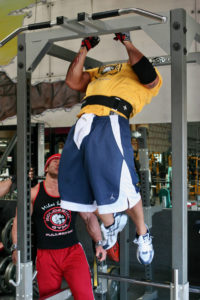Increase Your Pulling Power with Stutter Reps

Going beyond the basics to shock your muscles into growth
By Strength Sensei CP
“Everything old is new again!” are lyrics in a popular song performed in the Oscar-winning 1979 film All That Jazz. It can also be an effective approach to overcome training plateaus. Case in point: Stutter Reps.
I was introduced to stutter reps in an Iron Man article by Bernard Centralla over three decades ago. I later learned that Miloš Šarčev believed stutter reps was a training method that would induce muscle growth when the basics become monotonous. The version I will share here involves performing isometric stops during the concentric contractions of an exercise. Not at the start or finish of a repetition, but in-between. Before getting into the details of this training method, let’s review a few concepts about loading parameters.
 To jump start you’re your back training, give stutter reps a try. (Photos by Miloš Šarčev)
To jump start you’re your back training, give stutter reps a try. (Photos by Miloš Šarčev)
Time under tension refers to how long a muscle contracts during a repetition. A repetition is divided into three parts: concentric, eccentrics, and isometric. Let’s take the bench press as an example.
The beginning of the bench press, with the bar held motionless with your arms extended, is an isometric contraction in the advantageous leverage position. Lowering the bar to your chest is an eccentric contraction, as the muscles contract while lengthening. Holding the bar motionless at the chest is another isometric contraction, but this time it is in the disadvantageous leverage position. Finally, pressing the weight to extended arms is a concentric contraction. The total time to complete all four phases of a repetition is the total time under tension (TUT).
As the speed of a repetition is increased, the TUT decreases. Thus, a snatch would have a much shorter total TUT than a back squat. For increasing strength and muscle mass, slow-speed training with a longer TUT with heavy weights is superior to high-speed lifting. Obviously, an isometric contraction will create a high level of muscle tension as no movement occurs. Plus, increasing the length of an isometric contraction increases the TUT of a repetition.
Stutter reps can be considered a derivative of functional isometric contractions (FIC), a term popularized by American sports scientists Steve Fleck, William Kraemer, and Patrick O’Shea. FIC involves pre-fatiguing the muscles with isometric contractions at various points of an exercise (such as with the bar positioned a few inches off the chest in a bench press). In contrast, stutter reps involve performing isometric contractions during the concentric and eccentric contractions.
I find stutter reps especially effective with chin-ups. For this exercise, and many of their variations, I favor single reps. For the concentric range, I like to prescribe 3-second isometrics stops – I typically have the athlete perform 5-6 of these stops. For the eccentric range, I will have the athlete lower the bar in 30 seconds, thus significantly prolonging the TUT for the rep. I usually recommend 5 singles. (FYI: When an individual can lower a chin-up in 30 seconds, they can usually perform one full repetition in good form.)
Yes, I’m a big believer in the basics, but sometimes, you need to “jazz” up your training to shock your muscles into growth. Stutter reps is one such method. (SS)
